Portal:Astronomy/Picture/June 2005
Featured pictures on the Astronomy Wikiportal, June 2005[edit]
|
1 June 2005 (edit) |
2 June 2005 (edit) |
 The city of Paris, photographed from Earth orbit by astronauts aboard the International Space Station. The River Seine winds its way through the center of the image. The gray and purple pixels are the urban areas, and the patchwork of green, brown, tan and yellow surrounding the city is farmland |
 The Hubble Space Telescope was launched in 1991, and revolutionised astronomy by returning images of unprecedented sharpness and angular resolution from its vantage point above the atmosphere. This photo was taken during the second servicing mission in 1997, during which astronauts replaced old instruments with new ones and repaired the guidance systems and thermal insulation of the space telescope |
|
3 June 2005 (edit) |
4 June 2005 (edit) |
|
From Earth, the surface of Venus is permanently hidden from view by a dense and global covering of sulphuric acid clouds. The only direct images of the surface were returned by the Soviet Venera program in the 1970s and 1980s. Several probes landed on the planet, but none survived for more than two hours before being destroyed by the fearsome temperatures and atmospheric pressure at the surface. This image was taken by the Venera 13 probe in 1982. |
 The Coalsack Nebula is a dark nebula in the constellation of Crux Australis. Dark nebulae consist of cold dense clouds of gas and dust, which are only seen because they obscure visible light from more distant objects. Dark nebulae are often the location of star formation, which can be revealed within them by observations at infrared and radio wavelengths, which are much less affected by absorption and scattering by interstellar material |
|
5 June 2005 (edit) |
6 June 2005 (edit) |
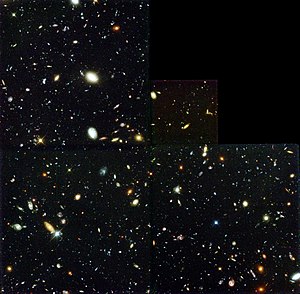 The Hubble Deep Field was produced in 1995 from images accumulated when the Hubble Space Telescope observed one very small patch of sky over 10 days. Almost every object seen in the HDF is a distant galaxy; only a few local stars contaminate the field. The HDF gave astronomers significant insights into the earliest stages of galaxy formation, and was later supplemented by the Hubble Deep Field South and the Hubble Ultra Deep Field |
 The collision of Comet Shoemaker-Levy 9 with Jupiter in 1994 was the first time astronomers had observed a collision between two Solar System bodies. This chain of craters on Jupiter's moon Ganymede provides evidence that comets must quite frequently be fragmented by the planet's gravity before colliding with it or its moons. |
|
7 June 2005 (edit) |
8 June 2005 (edit) |
 The Crab Nebula is the best known example of a supernova remnant. It formed when a massive star exploded as a supernova in 1054, an event that was witnessed and recorded by Chinese astronomers. Charles Messier included the nebula as the first object in his catalogue of objects which might be confused with comets |
 Near the centre of the globular cluster M4 lies the pulsar PSR B1620−26. The pulsar is extremely dense and only a few miles across, and rotates about 100 times per second, directing a pulse of electromagnetic radiation towards the earth once during each rotation. Small variations in the intervals between pulses reveal the presence of both a white dwarf and a large Jupiter-sized planet orbiting the pulsar. |
|
9 June 2005 (edit) |
10 June 2005 (edit) |
|
The Hubble Space Telescope has provided many spectacular images of planetary nebulae, revealing hitherto unexpected structure and detail in these remnants of medium and low mass stars. The Saturn Nebula was nicknamed by Lord Rosse in the 1840s due to a supposed resemblance in his telescope to the planet Saturn. |
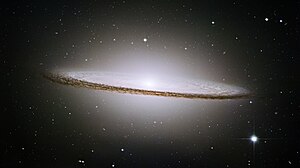 |
|
11 June 2005 (edit) |
12 June 2005 (edit) |
|
|
 |
|
13 June 2005 (edit) |
14 June 2005 (edit) |
 |
Centaurus A is named because it is the strongest source of radio waves in the constellation of Centaurus. It is the closest active galaxy to our own, and its intense radio emission can be seen extending in giant lobes from the centre of the galaxy in this combined optical and radio image. |
|
15 June 2005 (edit) |
16 June 2005 (edit) |
|
|
|
|
17 June 2005 (edit) |
18 June 2005 (edit) |
|
|
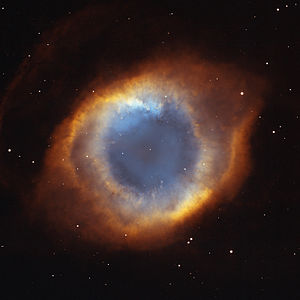 |
|
19 June 2005 (edit) |
20 June 2005 (edit) |
 |
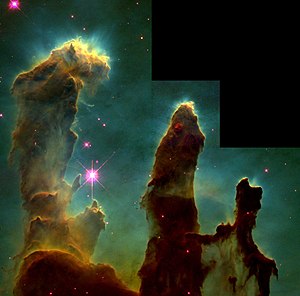 |
|
21 June 2005 (edit) |
22 June 2005 (edit) |
 |
|
|
23 June 2005 (edit) |
24 June 2005 (edit) |
|
The rings of Saturn are one of the most famous sights in the night sky, and are spectacular even when viewed through a very small telescope. They consist of millions of icy fragments extending over a region some 400,000 kilometres across. The origin of Saturn’s rings is not yet understood. |
 |
|
25 June 2005 (edit) |
26 June 2005 (edit) |
 |
 |
|
27 June 2005 (edit) |
28 June 2005 (edit) |
|
Venus is the brightest object in the sky after the Sun and the Moon, often appearing as a brilliant morning star or evening star. Its surface is completely obscured by dense clouds, which appear blank and featureless in visible light. Ultraviolet observations can reveal the otherwise-invisible detail and structure in the clouds. |
M91 is an example of a barred spiral galaxy, in which the spiral arms originate not from the nucleus of the galaxy but from the ends of a bar extending outwards from the nucleus. The origin of the bar in galaxies like this is not well understood. Recent evidence suggests our own galaxy may be a barred spiral. |
|
29 June 2005 (edit) |
30 June 2005 (edit) |
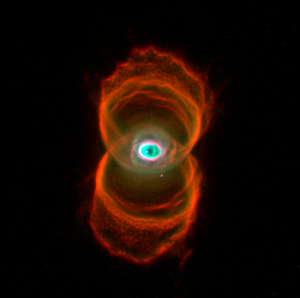 |
Pluto is the most distant planet from the Sun during most of its orbit, and is the least well studied – it is the only planet yet to be visited by a space probe. Debate continues as to whether it is even a planet at all. This image was produced by mapping brightness changes as Pluto was occulted by its moon Charon. |
|
31 June 2005 (edit) |
|
 |
|
